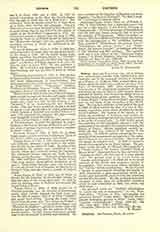

Didron, ADOLPHE-NAPOLEON, also called Didron aine, archaeologist, together with Viollet-le-Duc and Caumont, one of the principal revivers of Christian art in France; b. March 13, 1806, at Hautvillers, near Reims, where his father was a collector of taxes; d. at Paris, November 13, 1867. After completing his early studies at the preparatory seminaries of Meaux and Reims, he went to Paris in 1826, became there a professor of history, and devoted his leisure hours to following courses of law, medicine, etc. The reading of Victor Hugo’s “Notre Dame de Paris” gave him a taste for the study of the antiquities of the Middle Ages. Having been admitted to the circle of the poet in 1829, he there formed the plan of a tour in Normandy, a province noted above all others for its historical buildings. His reading of the legends of the saints, his knowledge of Scripture, and certain abstract notions of theology directed the young amateur to the study of iconography. In 1835 Guizot named him secretary to the committee entrusted with the publication of the unedited documents concerning the history of France. Didron published, entirely unaided, the first four volumes of the reports of the committee. In 1839 the portion concerning the iconography of the monumental monographs of the cathedral of Chartres was reserved for him. This work did not appear in complete form. In 1838 he opened a course of iconography at the Royal Library. He published (under the title of “Manuel d’Iconographie”) a French version of the famous “Painters’ Book of Mount Athos“, discovered there by him, and wrote the “Histoire de Dieu”, the first part of a more general work. His greatest work is the review known as “Annales archeologiques”, in which are to be found accounts of his travels and numerous studies in iconography. For many years Didron published in the “Univers” letters on archaeology. He also founded a library of archaeological literature, and finally, in 1849, constructed a glass-manufactory, which produced some remarkable pieces of work and continued to exist after his death. He also produced some good examples of work from the goldsmiths’ workshop which he had established in 1858, but which was short-lived.
His principal works are: “Bulletin archeologique du comite des arts et monuments” (4 vols., Paris, 1840-1847); “Histoire de Dieu, iconographie des personnes divines” (Paris, 1843); “Manuel d’iconographie chretienne, grecque et latine” (Paris, 1845);
R. MAERE

